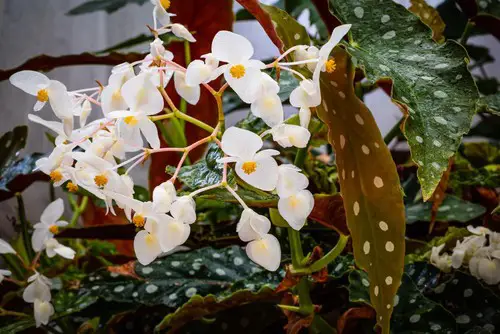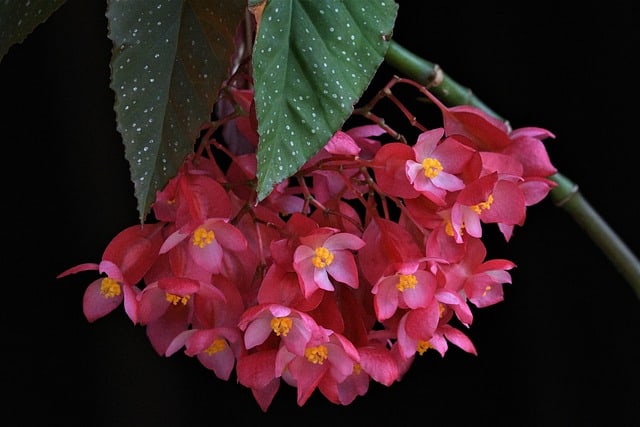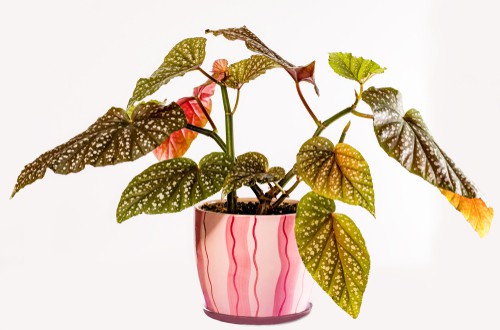Angel wings plants are a popular houseplant known for their beautiful foliage and easy care. However, sometimes you might notice your angel wings plant drooping, which can be a cause for concern for plant owners. As such it’s important to understand the symptoms, causes, and steps you can take to prevent and recover from drooping.
Identifying drooping symptoms is the first step in caring for your angel wings plant. Drooping leaves are a sign that something is not right with your plant. The leaves may appear limp, wilted, or even yellow or brown.
Understanding the causes of drooping can help you determine the best course of action to take. Overwatering, underwatering, root rot, and old age are some common causes of drooping in angel wings plants.
Preventing drooping is key to keeping your angel wings plant healthy. Proper watering and drainage, good soil quality, and appropriate lighting are all important factors in preventing drooping.
Recovery steps for a drooping angel wings plant can include adjusting watering habits, improving drainage, and removing dead or damaged leaves. With the right care, your angel wings plant can recover and thrive.
Key Takeaways
- Angel wings plants can experience drooping leaves, which is a sign that something is not right with the plant.
- Common causes of drooping include overwatering, underwatering, root rot, and old age.
- Preventing drooping through proper care and taking recovery steps can help your angel wings plant thrive.
Don’t miss these other popular picks:
Understanding Angel Wings Plant

Angel Wings Plant, also known as Begonia coccinea, is a beautiful and popular houseplant that is native to the tropical regions of South America. It is a low-maintenance plant that can add a touch of elegance to any indoor space.
Angel Wings Plant is a cane-type begonia, which means that it has thick, woody stems that can grow up to 2 feet tall. The leaves of the Angel Wings Plant are large, asymmetrical, and shaped like angel wings, hence the name. The leaves are usually green with silver spots or veins, but can also be red or pink.
Angel Wings Plant is a relatively easy plant to care for, but it can be susceptible to a few problems, such as drooping leaves. Drooping leaves are a common issue with Angel Wings Plant, and can be caused by a variety of factors, including overwatering, underwatering, poor lighting, and pests.
To keep Angel Wings Plant healthy and thriving, it is important to provide it with the right growing conditions. The following table summarizes the ideal growing conditions for Angel Wings Plant:
| Growing Conditions |
| Light: Bright, indirect light |
| Temperature: 65-75°F (18-24°C) |
| Humidity: 40-60% |
| Watering: Keep soil moist but not waterlogged |
| Soil: Well-draining, rich soil |
| Fertilizer: Once a month during growing season |
Identifying Drooping Symptoms
Angel wing plants are known for their beautiful, wing-shaped leaves, but drooping leaves can be a sign of stress or illness. Identifying the symptoms of drooping can help you determine the cause and take appropriate action.
1. Wilting
One of the most noticeable symptoms of drooping is wilting. The leaves of the plant may appear limp and weak, and they may droop down towards the ground. Wilting is often a sign of dehydration, so it’s important to check the soil moisture level and adjust watering accordingly.
2. Yellowing Leaves
Another symptom of drooping is yellowing leaves. The leaves may turn yellow and fall off the plant, which can be a sign of nutrient deficiency or disease. It’s important to monitor the plant for any signs of pests or disease and take appropriate action.
3. Soft Stems
Soft stems can also be a sign of drooping. The stems of the plant may feel soft and weak, which can be a sign of overwatering or root rot. It’s important to check the soil moisture level and ensure that the plant is not sitting in standing water.
4. Leggy Stems
Leggy stems are another symptom of drooping. The stems of the plant may become elongated and weak, which can be a sign of inadequate light or improper pruning. It’s important to ensure that the plant is getting enough light and to prune it regularly to encourage healthy growth.
Identifying the symptoms of drooping can help you determine the cause and take appropriate action to restore the health of your angel wing plant. By monitoring the plant for signs of wilting, yellowing leaves, soft stems, and leggy stems, you can ensure that your plant stays healthy and vibrant.
Angel Wings Plant Drooping – 7 Common Problems

Angel wing plants are beautiful and easy to care for, but sometimes their leaves can droop. There are several reasons why this can happen, and it is important to identify the cause so that the issue can be resolved.
1. Overwatering
Overwatering is one of the most common causes of drooping in angel wing plants. When the soil is constantly wet, the roots of the plant can become waterlogged and suffocate. This can cause the leaves to turn yellow and droop. It is important to water the plant only when the soil is dry to the touch, and to ensure that the pot has proper drainage.
2. Underwatering
On the other hand, underwatering can also cause drooping in angel wing plants. When the soil is too dry, the roots cannot absorb enough water to keep the leaves hydrated. This can cause the leaves to wilt and droop. It is important to water the plant regularly, but not too frequently, and to ensure that the soil is moist but not waterlogged.
3. Incorrect Lighting
Angel wing plants require bright, indirect light for optimal growth. If the plant receives too little light, its leaves might droop and lose their vibrancy. On the other hand, if the plant receives too much direct sunlight, the leaves might scorch and droop. It is important to find the right balance of light for the plant to thrive.
4. Temperature Fluctuations
Angel wing plants prefer warm, humid environments. Extreme temperature fluctuations can cause the leaves to droop and lose their color. It is important to keep the plant in a stable environment with a consistent temperature and humidity level.
5. Pest Infestation
Pests such as aphids, mealybugs, and spider mites can infest the leaves of an angel wing plant and cause them to droop. These pests can also leave behind a sticky residue on the leaves. It is important to inspect the plant regularly for signs of pest infestation and to treat it promptly if necessary.
6. Diseases and Fungus
Fungal diseases such as powdery mildew and mold can also cause the leaves of an angel wing plant to droop. These diseases are often caused by high humidity levels and poor air circulation. It is important to keep the plant in a well-ventilated area and to avoid getting the leaves wet when watering.
7. Stress
Stress can also cause the leaves of an angel wing plant to droop. Stress can be caused by a variety of factors, including transplant shock, pot size issues, and extreme temperature fluctuations. It is important to provide the plant with a stable environment and to avoid causing unnecessary stress.
Preventing Drooping in Angel Wings Plant

Angel wings plants are known for their unique foliage and stunning appearance. However, if they are not cared for properly, their leaves can start to droop, making them look less attractive. Fortunately, there are several steps that can be taken to prevent drooping in angel wings plants.
1. Proper Watering
One of the most common causes of drooping in angel wings plants is improper watering. It is important to ensure that the plant is not overwatered or underwatered. Overwatering can lead to root rot, which can cause the plant’s leaves to droop. On the other hand, underwatering can cause the plant to wilt and eventually die.
To prevent drooping, it is important to water the plant appropriately. The soil should be kept moist but not waterlogged. It is also important to ensure that the plant is not sitting in standing water, as this can lead to root rot. Adequate drainage holes in the pot can help prevent this.
2. Adequate Lighting
Another factor that can contribute to drooping in angel wings plants is insufficient light. These plants require bright, indirect light to thrive. If they are not getting enough light, their leaves can start to droop.
To prevent drooping, it is important to ensure that the plant is getting enough light. Placing the plant near a window that receives bright, indirect light can help. If the plant is not getting enough light, a grow light can be used to supplement natural light.
3. Maintaining Humidity Levels
Angel wings plants are native to humid environments, and they thrive in similar conditions in your home. Low humidity levels can cause their leaves to droop. To prevent this, it is important to maintain appropriate humidity levels.
Using a humidifier or placing the plant on a tray of water with pebbles can help maintain appropriate humidity levels. This will help prevent the plant from drooping due to low humidity.
4. Pest and Disease Management
Pests and diseases can also cause angel wings plants to droop. It is important to regularly check the plant for signs of pests or disease and take appropriate action if necessary. This can include using insecticidal soap or neem oil to treat pests, or removing infected leaves to prevent the spread of disease.
By following these steps, it is possible to prevent drooping in angel wings plants and keep them looking healthy and beautiful.
Recovery Steps for a Drooping Angel Wings Plant

If your angel wings plant is drooping, there are several steps you can take to help it recover. The first step is to identify the cause of the drooping and address it accordingly.
1. Repotting
One common cause of drooping in angel wings plants is root-bound plants. If the plant has outgrown its pot, it may not be able to absorb enough water and nutrients to support its growth. Repotting the plant into a larger pot can help alleviate this problem.
When repotting, choose a pot that is one size larger than the current pot. Fill the bottom of the new pot with a layer of potting mix and gently remove the plant from its old pot. Loosen any tangled roots and place the plant in the new pot. Fill the pot with potting soil, sandy soil or a mixture of both and add perlite to improve drainage.
2. Pruning
Another reason for drooping is overgrowth. When the plant becomes too large, it may not be able to support its own weight, causing the leaves to droop. Pruning the plant can help alleviate this problem.
To prune an angel wings plant, use clean, sharp scissors or pruning shears to remove any dead or damaged leaves. Cut back any overgrown stems to encourage new growth. Be sure to sterilize the tools before and after use to prevent the spread of disease.
3. Fertilization
Over-fertilization can also cause drooping in angel wings plants. If the plant is receiving too much fertilizer, it may be unable to absorb enough water, causing the leaves to droop. To prevent over-fertilization, only fertilize the plant when necessary and follow the instructions on the fertilizer package.
When fertilizing, use a balanced fertilizer that contains essential nutrients such as nitrogen, phosphorus, and potassium. Apply the fertilizer according to the instructions on the package and water the plant immediately after fertilization.
In conclusion, if your angel wings plant is drooping, it is important to address the underlying cause to help it recover. Repotting, pruning, and fertilization are all effective ways to help your plant regain its health and beauty.
Additional Care Tips for Angel Wings Plant

Indoor Vs Outdoor Care
Angel wings plant can be grown both indoors and outdoors. However, the care requirements can differ depending on where the plant is grown. If the plant is grown indoors, it is essential to ensure that it gets enough light.
Place the plant near a window where it can receive bright, indirect light. If the plant is grown outdoors, it is essential to protect it from direct sunlight, especially during the hottest part of the day.
Another important aspect of indoor vs outdoor care is watering. Indoor plants may require watering more frequently than outdoor plants, especially during the winter months when the air is dry. Outdoor plants may require less frequent watering, especially during the rainy season.
Seasonal Care Tips
Angel wings plant care requirements can also vary depending on the season. During the summer months, the plant may require more frequent watering due to the heat. It is essential to ensure that the soil is moist but not waterlogged. During the winter months, the plant may require less frequent watering, as the air is drier.
During the summer months, it is also essential to protect the plant from direct sunlight, as this can cause the leaves to scorch. In contrast, during the winter months, it is essential to protect the plant from cold drafts, as this can cause the leaves to wilt.
Another important aspect of seasonal care is pruning. Prune the plant regularly to promote healthy growth and prevent overcrowding. Additionally, taking cuttings from the plant and propagating them can help promote healthy growth and ensure that the plant remains healthy over time.
Frequently Asked Questions
Why are my Angel Wings turning yellow?
Yellowing leaves on an Angel Wings plant can be a sign of several issues. Overwatering, underwatering, nutrient deficiency, or pest infestation are some of the common causes. It is important to identify the root cause of the yellowing leaves to take appropriate action to save the plant.
How do I revive a drooping Angel Wings plant?
A drooping Angel Wings plant can be revived by identifying the cause of the drooping and taking appropriate action. Overwatering is a common cause of drooping, so make sure to adjust the watering schedule. Check for pests and nutrient deficiencies and treat the plant accordingly. Repotting the plant into fresh soil can also help revive a drooping Angel Wings plant.
What causes Angel Wings to rot?
Angel Wings plants are susceptible to root rot, which occurs when the roots become infected with fungus due to overwatering or poor drainage. It is important to ensure that the soil is well-draining and not waterlogged. Overwatering should be avoided, and the plant should be allowed to dry out between watering.
What pests commonly attack Angel Wings plants?
Angel Wings plants are susceptible to pests such as spider mites, mealybugs, and scale insects. These pests can cause damage to the leaves and stems of the plant, leading to yellowing and drooping. Regularly inspecting the plant for pests and treating them with appropriate insecticides can help prevent the infestation.
How often should I water my Angel Wings plant?
Angel Wings plants prefer to be kept slightly moist but not waterlogged. It is important to allow the soil to dry out between watering to prevent overwatering and root rot. The frequency of watering will depend on the climate, humidity, and soil type. As a general rule, watering once a week is sufficient.
Should I mist my Angel Wings plant?
Angel Wings plants prefer high humidity, so misting the leaves can be beneficial. However, misting should be done sparingly to prevent the leaves from becoming waterlogged, which can lead to fungal infections. A humidifier can also be used to increase the humidity around the plant.

Hey, I’m Lisa and I’ve been an avid gardener for over 30 years. I love writing, talking and living in the garden! Feel free to connect with me on my socials below

